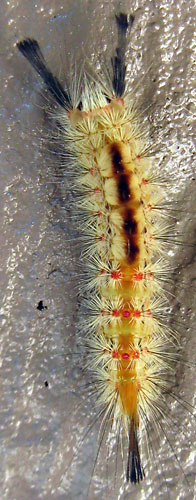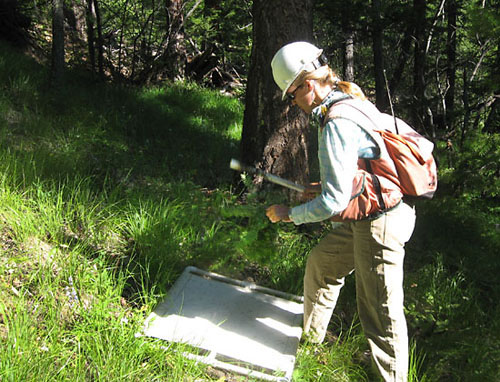home | internet service | web design | business directory | bulletin board | advertise | events calendar | contact | weather | cams

Spraying for Tussock Moth It worked, but did we need it?  Many people are allergic to contact with the tiny hairs of the tussock moth caterpillar. Many people are allergic to contact with the tiny hairs of the tussock moth caterpillar.
Spraying against tussock moths works, but it’s hard to know if and when to start. The recent Douglas-fir tussock moth outbreak in Methow Valley forests did less damage than expected, according to Forest Service entomologist Connie Mehmel. The progression of the outbreak highlighted the difficulties in determining when it’s appropriate to spray. Mehmel, based in Wenatchee, spent several weeks last summer in the valley overseeing the project that started after researchers found elevated levels of tussock moth. Since the 1970s, when a particularly devastating outbreak caused enormous damage in forests throughout the Western United States and parts of Canada, the Forest Service has been regularly monitoring the insect’s population. Forest Service workers annually check traps baited with a pheromone from the female tussock moth which attracts the male moths. “On a non-outbreak year the number of male moths you find in the traps would be very low. It might be one or two,” says Mehmel. When, however, that number starts to get to be 20, 30 or 40, it is a good indicator of a potential outbreak. The traps act only as an early warning system. Further field studies verify whether or not there is a population spike and if control measures should be implemented Last spring over a dozen Forest Service workers traipsed systematically through the woods at various elevations around the Methow Valley, examining the boughs of the moth’s preferred host, the Douglas-fir, for signs of the insect. Using plastic pipe, surveyors beat branch clippings over a clean cloth canvas and then sifted through the vast array of debris and micro-life jarred loose from the needles. Their eyes were trained to focus in on a tiny, furry caterpillar; the tussock moth at the nascent stage of its one-year life cycle. Emerging in spring from an egg mass the female tussock moth lays the previous fall, tussock moth caterpillars have a voracious appetite. They begin by feasting on the tender new growth, eventually moving on to the more seasoned needles of the Douglas-fir and other true firs through the course of the summer. In a normal year, the damage to trees is minimal, but in an outbreak year, entire forests can be defoliated. Many people are allergic to the tiny hairs of the tussock moth caterpillar and can react with everything from skin rashes to respiratory problems. After completing the intensive field research and surveys in June of 2010, the number of tussock moth caterpillars Mehmel found in sample trees supported the conclusion that tussock moths had reached outbreak levels in parts of the Methow Valley.  Forest Service workers look for tussock moths by beating branch clippings over clean canvas and sifting through what was shaken loose. Forest Service workers look for tussock moths by beating branch clippings over clean canvas and sifting through what was shaken loose.
Mehmel and her crew switched gears to treatment mode. The Okanogan Wenatchee National Forest, which manages the federal land surrounding the Methow Valley, had previously developed a policy dictating aggressive action to prevent tree mortality on its forests in the event of a tussock moth outbreak. Not every tree, though, is assured the same protective measures. Insecticide is sprayed only in places that meet established criteria. For the Methow Valley this includes areas that are adjacent to private land, contain old growth Douglas-fir, are designated as places of visual and recreational value, and encompass a seed orchard located at Pole Pick on the Loup. The treatment is designed to interrupt an outbreak, which typically follows a four-year cycle. During the first two years, the tussock moth population begins to grow; during the latter two, it reaches explosive levels before collapsing. A naturally occurring virus within the population precipitates the decline. When the tussock moth multiplies to concentrated, high numbers, the deadly virus is readily spread. The virus “causes the caterpillar’s guts to liquefy. When this happens, the carcasses hang upside down by their back legs on a branch,” explains Mehmel. In a sci-fi-like death drama, “the bodies swell and swell until finally they burst. Virus particles are spread everywhere. Those particles land on needles, and other caterpillars come along and eat it and become infected.” In order to treat a tussock moth outbreak, Forest Service scientists developed an insecticide with ingredients from the virus. Mixed in small quantities with water and molasses so that it sticks to the needles, the insecticide is sprayed aerially using helicopters. The virus is introduced at a lethal level earlier in the outbreak, accelerating the resulting population dieback and thus diminishing the number of trees defoliated. Last year approximately 13,000 acres around the Methow Valley were treated with the insecticide.  Tussock moth caterpillars kill trees by defoliating them. Spraying is done to prevent that by accelerating a natural cycle of moth population collapse. Tussock moth caterpillars kill trees by defoliating them. Spraying is done to prevent that by accelerating a natural cycle of moth population collapse.
According to Mehmel, “caterpillars that were collected right after spraying started dying immediately, within 24 hours.” As a particular point of interest she adds, “The caterpillars that were brought in from areas that weren’t sprayed, lived for about three more weeks. They then started dying in large numbers and not very many of them made it through to adult moths.” This indicates that in 2010 the tussock moth population was essentially already near its collapse point. Spraying worked: more moths died in the treated areas. But Mehmel reiterates that what really matters is tree mortality. “The objective of the treatment wasn’t to kill caterpillars; the objective was to prevent tree defoliation.” To this end Mehmel notes that the outbreak may not have been as damaging as expected. “The areas we didn’t spray got more defoliation than the areas we did. But nowhere was the defoliation what you would call severe. It was light to moderate.” For Mehmel this raises the question: “How high does the population (of tussock moth caterpillars) have to be before you are going to get damage?” The Forest Service sprayed last year using the best available research-based decision-making model about when to start spraying. The model is based on the relationship between the insect’s population and tree mortality. But as Mehmel points out, “biological systems are complex.” The Forest Service had set aside a million dollar budget to fight the tussock moth on the forest. Mehmel and her crew and helicopters spent $689,000 and turned back the rest. Mehmel hopes that studies now under way on a tussock moth outbreak in Idaho will continue to refine the science and the trigger point for starting to spray. With regards to last year’s spraying, Mehmel doesn’t feel the effort was wasted. “I don’t think (spraying) was necessarily a mistake. We weren’t far from a damaging population. We just weren’t maybe quite there. Knowing that your knowledge is never going to be perfect, we’d like to make it better.” As an analogy Mehmel views the spray project “almost like taking a vaccination. You get vaccinated against the disease, but maybe you would never have gotten sick anyway. But you know the possibility is there. And if it happens, you wouldn’t have wanted it to.” Based on the average time span between tussock moth outbreaks, the Methow Valley won’t require another vaccination for another 10 to 20 years. 10/4/2011 |